How Economic and Political Factors Drive the Oil Strategy of Gulf Arab States

Table of Contents
Author(s)
Share this Publication
- Print This Publication
- Cite This Publication Copy Citation
Alsayegh, Osamah. 2023. How Economic and Political Factors Drive the Oil Strategy of Gulf Arab States — And What this Means in the Context of the Global Energy Transition. Research paper no. 01.09.23. Rice University's Baker Institute for Public Policy, Houston, Texas. https://doi.org/10.25613/KPSA-QK94.
Abstract
The Arabian (Persian) Gulf region has been at the center of global attention for the past century. Due to its strategic geographic location and rich hydrocarbon resources, the Gulf has played a key role in political and economic developments around the world. The Gulf states have relied on their abundance of hydrocarbons, particularly oil, to pursue economic and political activities that serve their national interests — in many cases fueling geopolitical tensions with other global actors. In order to mitigate regional and global conflict, it is imperative to recognize and address the factors that drive the evolution and development of the Gulf oil strategy.
This paper models the common oil strategy mechanisms used by major oil-producing Gulf countries. The model structure consists of three modules: 1) features, including the historic, present and future oil-related events and affairs of an era; 2) drivers, which are the resulting reaction policies to the era’s features; and 3) the grand strategy, or the overarching plan to fulfill the drivers’ policies. The model is employed to envision the Gulf oil strategy in the context of the global energy transition and the move toward net-zero carbon emissions in the coming three decades. The International Energy Agency’s World Energy Outlook 2022 scenarios are used as case studies for the model. Under the status quo scenario, in which countries around the world continue to work toward meeting energy and environmental targets, the Gulf oil producers would also stay on their present route: pursuing their economic interests by maximizing oil export revenues through balanced relations with the world’s main actors. In a scenario where global energy and climate commitments are met on time, the Gulf would pursue a resilient oil strategy, working to increase market shares of the non-energy use of hydrocarbon products and expand investments in and ownership of clean energy technologies. Lastly, under a scenario of achieving a 1.5°C stabilization in global average temperature by 2050, the Gulf oil strategy would have to decouple oil revenues from its economic growth. In the latter scenario, the Gulf states would face increasing local, political, economic and foreign policy challenges.
Introduction
The foreign and domestic policies of the Gulf Arab countries (Bahrain, Kuwait, Oman, Qatar, Saudi Arabia and the United Arab Emirates, or UAE) significantly affect global energy security, international stability and global markets. It is therefore imperative to closely analyze the Gulf’s policies, especially those concerning energy, given that the region holds more than 30% of the world's proven crude oil and 20% of its natural gas reserves.[1] The quantity of these resources varies across the Gulf states. Ranking the Gulf states according to their oil reserves, Saudi Arabia is first with 17.2%, Kuwait is second with 6.0%, the UAE holds 5.6%, Qatar has 1.5%, Oman has 0.7%, and Bahrain comes last with 0.007% of the world’s proven oil reserves by the end of 2020. Currently, Saudi Arabia, Kuwait and the UAE are members of the Organization of the Petroleum Exporting Countries (OPEC). Qatar, which terminated its OPEC membership in January 2019, is the leading source of natural gas in the Gulf region with 13.1% of the world’s proven gas reserves. Saudi Arabia and the UAE come second with 3.2% each, Kuwait holds 0.9%, Oman has 0.4%, and Bahrain’s proven gas reserves are negligible.
Focusing on oil as the area’s leading strategic commodity, most of the world oil crises from the 1970s onward were either triggered or relieved by the oil producers in the Gulf region. A few examples include: the 1973 Arab oil embargo, in which the members of the Organization of Arab Petroleum Exporting Countries (OAPEC), led by Saudi Arabia, banned oil exports to nations that supported Israel;[2] the 1979 oil shock, which occurred in the wake of the Iranian Revolution and caused a large drop in oil production;[3] the 1990 oil price shock due to the Iraqi invasion of Kuwait; the Saudi Arabia-Russia oil price war in March 2020 and its impact on the collapse of oil markets;[4] and the October 2022 OPEC+ decision to cut 2.0 million barrels a day of its oil production, which heightened tensions between the U.S. and Saudi Arabia (which leads OPEC+). The impact and role of the Gulf region in relieving energy supply shortages and stabilizing global energy markets cannot be understated.
As Gulf states and other nations around the world face the challenge of moving toward net-zero carbon emissions, questions emerge about the impact of the energy transition on the economic well-being, politics and regional stability of the Gulf in general. Given the geopolitical importance of the region, it is vital to analyze the current energy policies of Gulf states — as well as their future direction — in the context of the energy transition and net-zero goals.
This paper focuses on oil-producing Gulf countries that are members of OPEC — i.e., Saudi Arabia, the UAE and Kuwait. Though each of these three countries has its own energy strategy,[5] they all share common ground involving the monetization of oil assets to support their domestic economies and protect their national interests. This common strategy was indirectly stated at the Jeddah Summit for Security and Development in Saudi Arabia, which took place with U.S. counterparts, including President Joe Biden, on July 15 and 16, 2022. At the summit, Saudi Crown Prince Mohammad Bin Salman expressed the Gulf hydrocarbon producers’ common concerns about phasing out oil from the energy system and their interest in monetizing their oil assets. In general, Gulf states are purportedly working toward the following aims: (i) adopting a balanced approach — through a gradual and responsible transition toward more sustainable energy sources and emissions mitigation — that avoids exacerbating inflation, unemployment and social and security problems while keeping energy prices low; (ii) integrating clean energy technologies with hydrocarbon industrial systems, (iii) investing in fossil fuels while also encouraging the development of clean energy technologies in the next two decades. These aims reveal policy implications that could affect the internal and foreign affairs of oil-producing Gulf nations.
This paper models the effects of long-term energy policies rather than “action-reaction” short-term tactics. The model is evidence-based and focuses on major oil-producing countries in the Gulf (Saudi Arabia, the UAE and Kuwait). Historical data is used to identify the drivers for adopting a particular oil strategy, and the rationale of the present strategy is analyzed in an attempt to depict the Gulf oil strategy outlook. The developed model is comprised of three modules, which are hierarchical in logic. The base module, called the features, incorporates oil-related events and affairs of the era. The second module (the drivers) involves the policies developed in reaction to the features. The third module is the grand strategy outcome, produced by the drivers. The International Energy Agency’s (IEA) World Energy Outlook (WEO) 2022 scenarios are used as case studies and applied to the model in order to examine the potential long-term oil strategies of the Gulf countries in question.
Section 1 provides historical context about global oil supply and demand security dynamics and developments, establishing a general framework for the proposed model. Section 2 reviews the socioeconomic structure of Gulf states and identifies their motives for taking on particular energy policies — particularly the economic factors, which are one part of the modeling analysis. Section 3 examines the second part of the modeling analysis: the Gulf region’s geopolitical developments and international relations. Section 4 proposes a model of the Arab Gulf oil strategy that compiles economic and political drivers. Finally, the conclusion offers a discussion of the study’s findings and potential future developments. Ultimately, the model’s findings indicate that the most ambitious of the IEA’s World Energy Outlook scenarios would result in drastic economic and political challenges for the Gulf region.
1. The Gulf’s Three Oil Strategy Eras
Analyzing the current oil-related affairs of the Gulf’s major oil-producing countries requires an understanding of the region’s historical evolution. This section reviews regional and global oil-related geopolitical events to establish a general framework for the proposed model.
From the 1910s to 1940s, a time period encompassing both WW I and WW II, political affairs in the Gulf states were primarily centered on maintaining oil supply to fuel armies, and foreign oil companies primarily controlled the region’s energy resources. In the following two decades, the 1950s and 1960s, the world saw a period of sustained economic development and rising energy demand, mainly demand for oil and oil products. At that time, the Western oil majors — including Anglo-Persian Oil Co. (now BP), Texaco (now Chevron), Royal Dutch Shell and the Standard Oil Company of New York (now ExxonMobil) — guided the oil supply market toward low prices. Accordingly, oil-exporting countries were increasingly dissatisfied, and as a result, the Organization of Petroleum Exporting Countries (OPEC) was formed in 1960 to counterbalance the control of oil majors.[6]
In the 1970s, vital geopolitical events — including oil embargoes by the Arab oil-producing countries (mostly the Gulf states) in 1973, the nationalization of oil assets by many OPEC countries and the independence of the Gulf states — led to rising oil prices.[7] As a result, importing countries started to adopt energy security policies as countermeasures, e.g., the establishment of the International Energy Agency in 1974. In this era, oil supply was exploited to enforce political agendas. Between the late 1970s and the 1990s — a period encompassing Iran’s Islamic Revolution in 1978-79, the first Gulf War (the Iraq-Iran war) in 1980-88, the establishment of the Gulf Cooperation Council in 1981 and the second Gulf War (Iraqi occupation of Kuwait) in 1990-91 — the “oil for security” partnership between the Gulf and the West, particularly the U.S., was established.
The 1990s witnessed an additional set of broader geopolitical and economic developments, such as the collapse of the Soviet Union in 1991, the trend toward privatization and liberalization of energy industries and markets, more integration of national oil companies with importing countries, and the institutionalization of policies to address global warming, e.g., the Kyoto Protocol and the UN Conference of the Parties (COP). Oil demand security emerged as an issue of concern for net-exporting countries, and maintaining economic prosperity became the major policy driver of economic diversification and national development in these countries.
In the 2000s and 2010s, a number of events and developments — including the 9/11 terrorist attacks, the wars in Afghanistan and Iraq, the Arab Spring, developments in Iran’s nuclear program, the oil shale revolution, the growing cost competitiveness of renewable energy and clean technologies, and the high level of global electrification and pro-active environmental actions (e.g., COP) — added further strains that impacted and altered U.S. foreign policy across the administrations of George W. Bush, Barack Obama and Donald Trump. Together, these developments disturbed the “oil for security” relationship between the Gulf and the U.S., and further deepened concerns over national security and oil demand security for Gulf states.
In summary, the Arab Gulf has adopted three oil strategies over the past seven decades, each exercised in a distinct era. In the first era, the 1950s to mid-1970s, all Gulf states became fully independent sovereign states, general public opinion was highly sympathetic to Arab nationalism, Gulf economies were primitive in structure, populations were small, institutions rudimentary, and oil export income revenues relatively high (especially per capita) and fully under the control of the ruling elites. Accordingly, the strategy was to use oil as a political pressure tool to fulfill rulers’ aspirations.
In the following era, from the mid-1970s to the mid-2010s, Gulf states’ economies and populations grew, tensions and conflicts in the region continued (e.g., the Arab-Israeli conflict and the Iraq-Iran war), and ruling elites attempted to maintain domestic political stability by utilizing their oil wealth to fund highly intensive social programs (e.g., subsidies, free education, health services and tax-free systems). In the midst of this, the Gulf countries needed a world power guardian to uphold their security; hence, the “oil for security” strategy was adopted.
The third era, i.e., the mid-2010s to the present, has been characterized by the rise of a younger demographic, an increasing unemployment rate and the gradual reduction of subsidies in Gulf states. Furthermore, tensions and conflicts (e.g., Iran’s nuclear program and the war in Yemen) have continued, more oil producers (e.g., U.S. shale, East African countries) have been competing for market share, the global energy transition has been proceeding toward decarbonization, and climate change has led to institutionalized policies to phase out fossil fuels. All of this has altered their priorities, and the Gulf region has lost the full-fledged “oil for security” privilege. As a result, Gulf states have embraced a strategy that (i) fully exploits oil to advance its economic interests and (ii) has unbiased and balanced relations with the world’s major actors.
2. How Economic Interests Drive the Gulf Oil Strategy
The chronic economic dilemma of the Gulf’s oil-producing countries is the limitation of sector diversification. The Gulf’s economic prosperity highly depends on oil export revenues. In 2020, Gulf states’ fuel exports ranged from about 70% to 90% of total exports in the region, and the average oil rent percentage accounted for 20% of their gross domestic product (GDP) (Figure 1).[8] By comparing the above figures with those from developed oil-producing economic countries, e.g., Norway and the U.S., the critical nature of oil as a commodity for Gulf economies becomes evident. Indeed, the Gulf states’ economies are highly correlated with oil prices — as observed from their GDP profile trends[9] (Figure 2) — which makes them extremely vulnerable to oil price volatility.
Figure 1 — The Extent of Economic Dependence on Oil
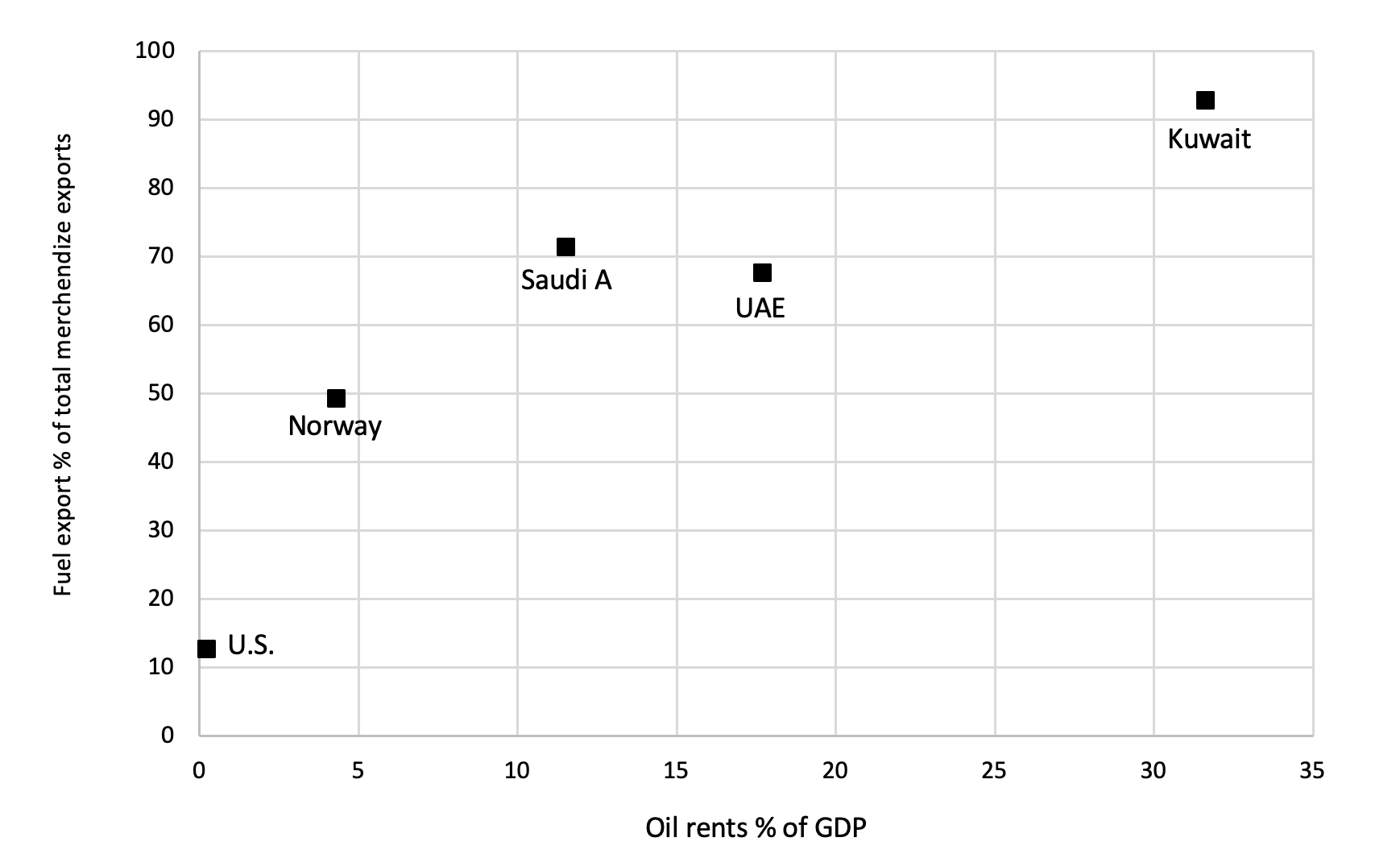
The impact of oil prices and demand levels was evident throughout the COVID-19 pandemic. The subsequent global economic recession and resulting low oil demand and prices were strongly reflected in Gulf states’ fiscal balances, which suffered deficits reaching an average of 9.0% of their GDPs in 2020. As economies rebounded and oil prices increased after lockdowns were eased, the fiscal balances improved to an average deficit of 4.0% in 2021[10] (Figure 3). Importantly, the Gulf states require a minimum average of U.S. $70/barrel to run their sectors[11] (Figure 4).
Figure 2 — Influence of Oil Price on GDP
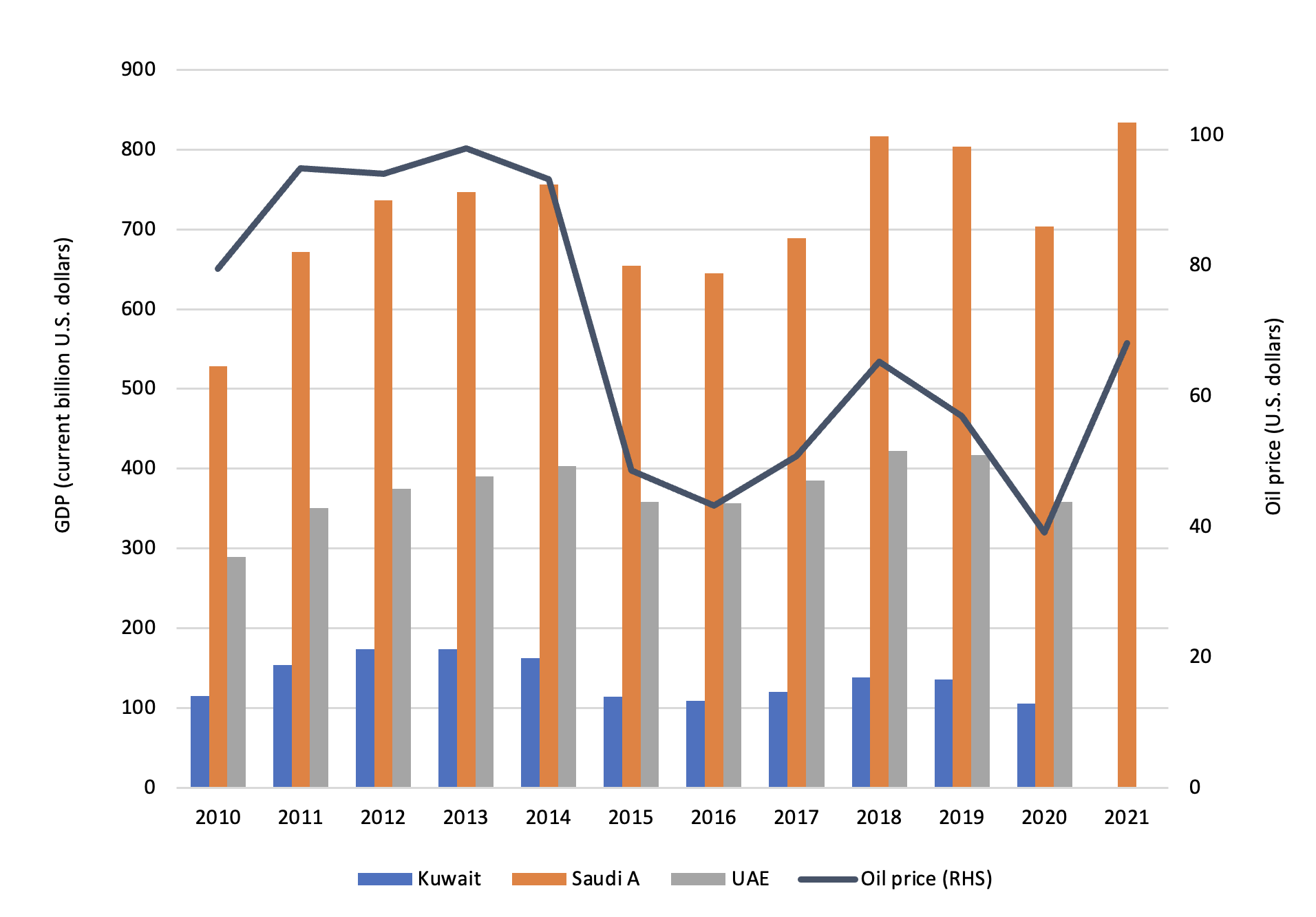
Figure 3 — Impact of Oil Prices on Gulf States’ Fiscal Balance
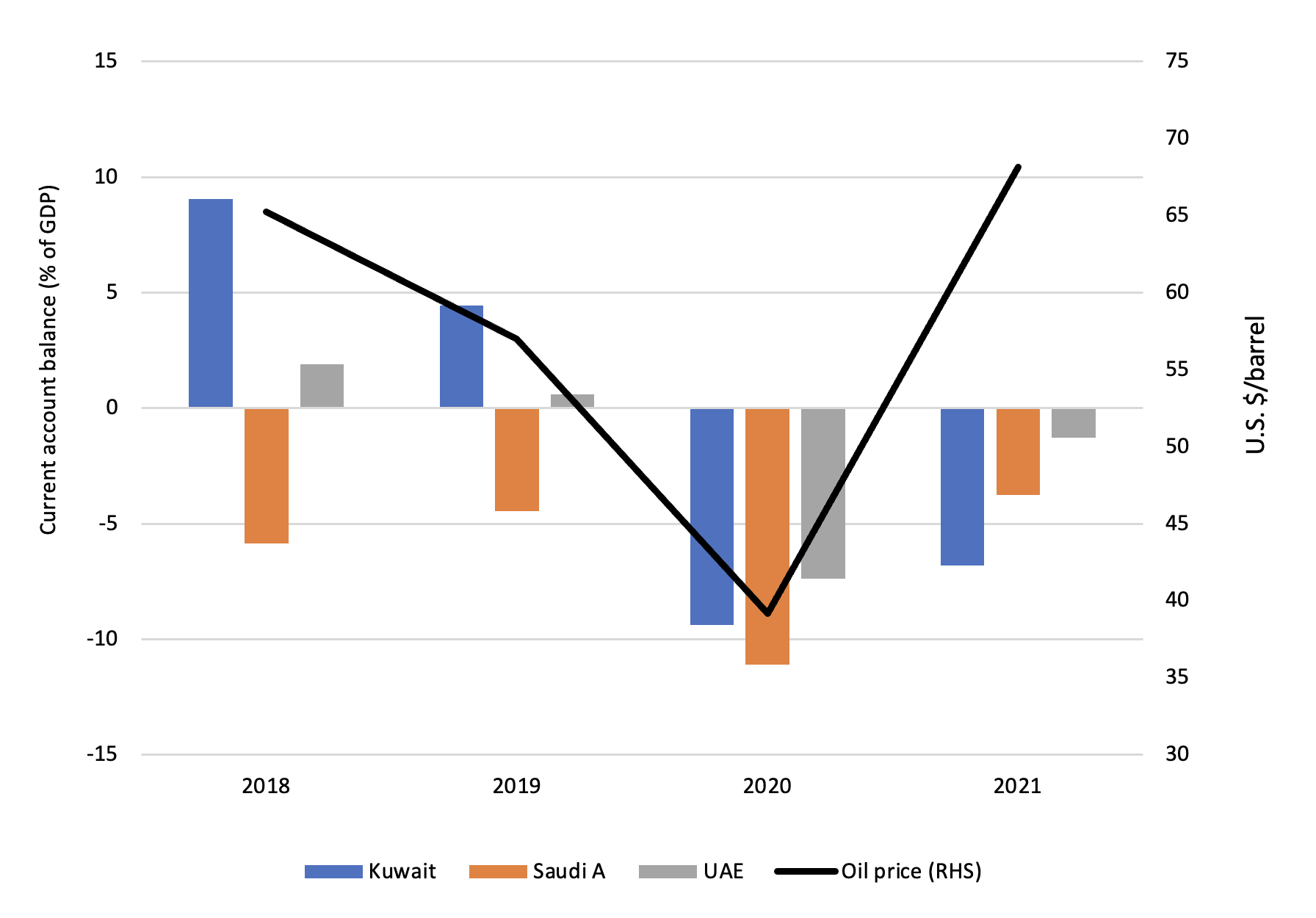
A number of complex political-economic barriers maintain the status quo and stand in the way of diversifying the Gulf economies.[12] Gulf governments rely on public sector jobs, free social services and high subsidies to transfer hydrocarbon wealth to their citizens. There is no genuine private sector in the Gulf. The so-called “private sector” depends directly on the Gulf governments’ projects, which are ultimately funded by oil export revenues. Almost all of the major economic activities — including initial investments, establishments, and the operation and maintenance of construction and infrastructure — are funded by oil revenues via Gulf state governments. Furthermore, these major projects are mostly exclusive to a few local merchant families who receive the benefits of oil rents through government contracts, i.e., an oligopoly system. With exclusive licenses from the governments, those merchants generate excess income and profits from their establishments and leave no room for fair competition in domestic markets.[13] Additionally, the businesses of the local elites are highly dependent on cheap expatriate labor[14] (mainly from Asia), though there is a minimal national labor quota demanded by the law.
Figure 4 — The Fiscal Breakeven Oil Price for Oil-exporting Gulf States
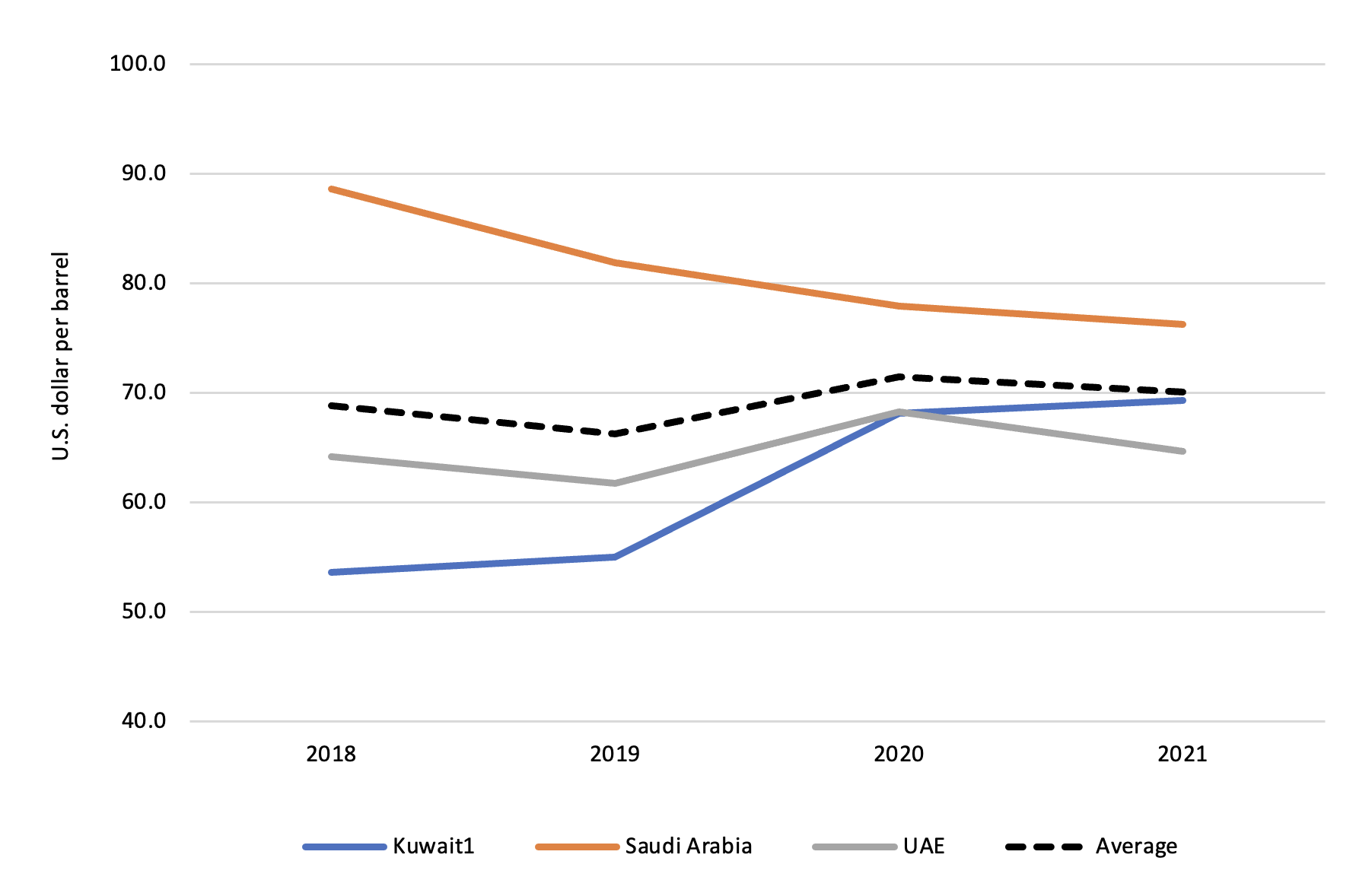
The policy dilemma, which the Gulf states have not yet been able to resolve, is how to bolster the production of goods and services that are not dependent, directly or indirectly, on the hydrocarbon sector. The challenge is not only producing goods and services that are independent of oil rents, but also ensuring the quality level needed for these goods and services to compete in international markets. Given the harsh climate and water scarcity in the Gulf region, agriculture is not a reliable sector. Manufacturing could be an opportunity. However, the modest availability of skilled labor and limited raw materials would curb the manufacturing sector’s functionality, making it difficult to compete against low-cost manufacturers in Asia. Similarly, developing high-tech knowledge economies, which most Gulf states have listed in their visionary plans, requires highly skilled workers and research facilities that are currently lacking in the region.
The option of transforming the Gulf states into financial and commercial hubs has already been fulfilled in the city of Dubai, which is unsurprising given that Dubai’s oil production peaked in 1991, giving early impetus to measures designed to diversify the economy. However, having an additional Dubai-like hub in the region might not be realistic for other Gulf states, given the geographic proximity.
One can conclude that Gulf countries will not achieve a diversified economy that’s less dependent on oil in the short- or medium-terms. The process to diversify takes time, perhaps even 25 to 30 years. It would involve reforming education, building a capable and motivated national workforce outside of the public sector, establishing a science, technology and innovation national infrastructure system, and developing legislation and legal frameworks to involve citizens more closely in wealth and economic diversification efforts. Long-term trends will most likely include: (i) oil continuing to dominate the Gulf’s income revenue exports and (ii) oil prices continuing to be critical in maintaining the Gulf’s domestic sectors, national development programs and political stability. Ultimately, the Gulf's actions to maintain certain oil price levels and its market share are intended to fuel its economy and bolster its national security.
The Gulf’s third oil strategy era was most evident in the October 2022 decision by Gulf state members of OPEC+[15] to reduce oil production by 2.0 million barrels per day from the August 2022 production level, starting in November and continuing until December 2023. Despite pressure from its traditional western allies — including former British Prime Minister Boris Johnson in March 2022, French President Emmanuel Macron in July 2022, German Chancellor Olaf Scholz in September 2022, and the U.S. government in October 2022 — the Gulf OPEC+ members, led by Saudi Arabia, approved the production cuts. Recent analyses suggest the decision was political in nature,[16] but several economic drivers, as shown in Figures 2-4, also provide rationale for the decision.
Figure 5 sheds some light on the recent OPEC+ oil cut dynamics. From the start of 2022 and before the Russian invasion of Ukraine on February 24, the average oil price was U.S. $87/barrel and OPEC+ countries were producing 40.89 million barrels a day. As a result of the Russian invasion of Ukraine, the oil price spiked to more than U.S. $120/barrel. Even before President Biden visited Saudi Arabia and attended the Jeddah Summit for Security and Development in mid-July, OPEC+ had gradually increased oil production from 40.89 million to more than 43.21 million barrels per day. The oil prices were about U.S. $98/barrel when Biden visited Saudi Arabia, though the White House stated that President Biden’s visit was not primarily focused on requesting an oil production increase. OPEC+ continued to gradually increase oil production, reaching almost 44.0 million barrels per day in September and causing oil prices to drop as far as U.S. $80/barrel. Releasing more oil from the U.S. strategic petroleum reserve was one of the major factors that brought oil prices down. However, an explosion on the Nord Stream gas pipeline on September 26, in addition to high global inflation rates and the already developing geopolitical conflict between Europe and Russia, raised the oil price to U.S. $90s/barrel. Since then, the price has been fluctuating within the upper U.S. $80s/barrel.
The above description of OPEC+ production dynamics implies that Gulf OPEC+ members (mainly Saudi Arabia) were responding to oil market fluctuations and making the decision to stabilize oil prices to the desired level regardless of their world partners’ interests.
Figure 5 — Daily Crude Oil Prices Versus OPEC+ Production
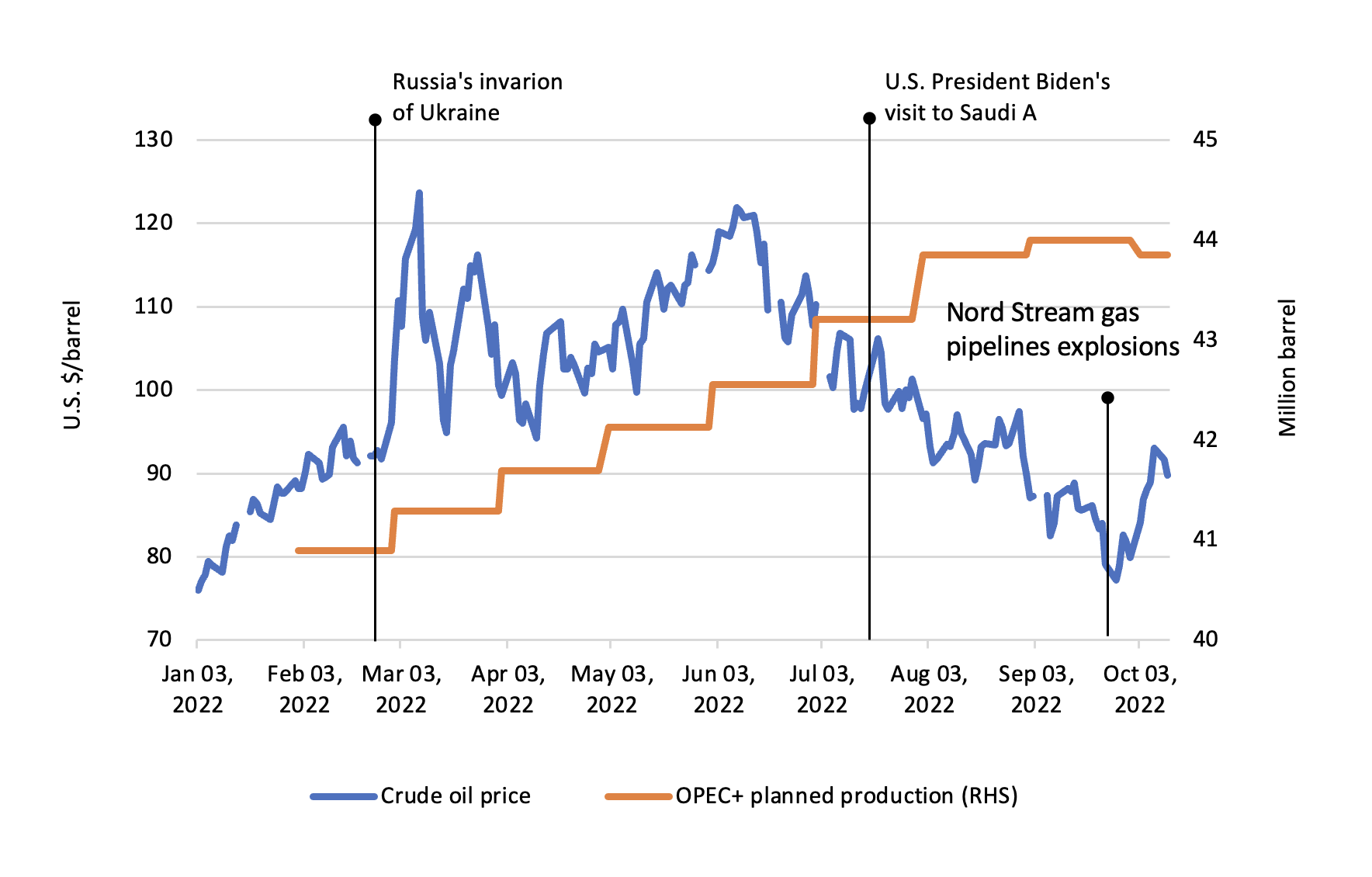
There is a gray area between economic interests and political pressures, and the latter is often exercised to support and protect national wealth. Similarly, economic prosperity is frequently utilized to achieve political gains and ultimately to protect national security.
3. The Nexus of Economic Interests, Politics and National Security — And the Impact on the Gulf’s Oil Strategy
A primary pillar of national security is the maintenance of economic stability and societal prosperity. Therefore, protecting national security by seeking to preserve economic interests involves the careful calculation of political objectives. Such maneuvers require balanced relations with the world’s powers and indirect influence on main international actors to protect national interests. The Gulf states’ oil production strategy pursues economic prosperity; hence, it requires soft power tools — including trade, investment and diplomacy — to achieve their goals.
By not responding to or cooperating with its traditional strategic partners, i.e., the U.S. and Europe, on particular issues, the Gulf states are practicing a strategy of protecting their national interests and security by (i) monetizing their hydrocarbon assets, (ii) balancing relations with the world’s powers, and (iii) practicing indirect and soft power to influence international actors to protect their national interests. In the present era, the Gulf is no longer dependent on its traditional partners, who need to realize and reform their relationship strategy.[17] The Gulf states’ attempts to balance relations with the world’s powers are driven by national economic goals, not alliances.[18]
A key turning point in the Gulf's international relations strategy was when the U.S. started reducing its military presence in the region in the 2010s. The reduced presence of the U.S. in the Gulf increased the competition between Saudi Arabia and Iran over the region's leadership. Economic tools have been the dominant mechanisms to gain political authority. Such tools include making strategic global investments, financing wars and militias, and contributing financial aid to countries and international organizations. Oil and gas revenues form the backbone of these economic approaches. Accordingly, the Gulf region is actively developing and growing its infrastructure, including its logistics, energy, communication and construction sectors. An efficient infrastructure offers nations advantages and supremacy over rivals. Thus, the Gulf region is driven to adopt a balanced relation strategy to achieve its visionary goals. These goals are an opportunity for other major international actors — including China, Russia and India — to accomplish their visionary plans. The Gulf’s relations with China and Russia offer tangible evidence of the Gulf's strategy development.
3.1 Growing Gulf-China Relations: A Case Study
In a recent statement, China’s President Xi Jinping asserted that “China will not rush its clean energy transformation.”[19] Saudi Crown Prince Mohammad Bin Salman also recently expressed comparable intentions reflecting all Gulf hydrocarbon producers' perspectives. These intentions and viewpoints involve adopting a balanced approach through a gradual transition toward sustainable energy sources and increasing investments in fossil fuel sectors.[20]
In 2020, China’s crude oil demand level was 20% of the world’s total demand — the second highest in the world with a consumption of 14.2 million barrels per day.[21] The Gulf states (Saudi Arabia, the UAE and Kuwait) supplied 26% of China’s total demand for crude oil.[22] Moreover, China’s refining capacity was at almost 17.0 million barrels per day,[23] and it is expected to reach 18.8 million barrels per day by 2023, giving it the world’s highest capacity.[24] This presents an opportunity for the Gulf that aligns with its economic goals.
Furthermore, the Middle East is a vital region for China’s Belt and Road Initiative (BRI). The objective of the BRI is to establish trading routes connecting China with the rest of the world. It involves massive infrastructure investments to serve its purpose. The BRI is also an opportunity for the Gulf to diversify its economy beyond hydrocarbons and support its other economic sectors. All Gulf states signed the BRI’s memorandum of understanding in 2018.[25] The UAE was already an active trading partner with China before joining the BRI, with bilateral trade exceeding U.S. $50 billion in 2019.[26] In the second quarter of 2019, the UAE signed contracts worth U.S. $3.4 billion under the BRI, including a contract for the Traders Market station in Dubai to link Asian and European markets.[27] Additional BRI investments in Abu Dhabi involve the China-UAE Industrial Capacity Cooperation Demonstration Zone, which attracted more than U.S. $505 million in investment in the past three years.[28]
Saudi Arabia was reported to be the largest recipient of Chinese investment in regard to the BRI during the first half of 2022.[29] Saudi Arabia was the key recipient of gas investments with U.S. $4.6 billion. Its exported merchandise to China reached U.S. $38.4 billion in May 2022, which is an 80% increase compared to the same month in 2021. In early 2022, Kuwait and China reached an agreement to associate the BRI with Kuwait's Vision 2035. The two sides agreed to cooperate in areas of agriculture and food security, energy, 5G telecommunications and smart cities.[30]
Some observers have criticized the BRI as being a debt trap and a means to advance China’s political agenda, enabling it to control vital infrastructure in low-income nations.[31] However, China and the Gulf states are peers (investment-wise), and the BRI initiatives have been framed to meet the Gulf and China’s common interests regarding hydrocarbons, logistics and trade.
3.2 Gulf Relations with Russia and Shared Hydrocarbon Interests
Compared to Gulf trade with China, the U.S. and Europe, the volume of trade between Russia and the Gulf states is low. Nonetheless, it grew a remarkable 185% from 2010 to 2019, reaching U.S. $4.4 billion in 2019.[32] Trends indicate that trade will continue to grow for merchandise and services involving the agriculture, military, nuclear, oil, gas and petrochemical sectors. Additionally, most Gulf states have invested in the Russian economy via the Russian Direct Investment Fund and oil and gas companies. The Gulf investments in Russia are reported to be some of the largest and most influential.[33] (See Table 1 for a list of major Gulf investments in Russia.) Although the investment values are relatively low when compared to Gulf investments in the U.S. or Europe, the quality of the investments makes them of significant and critical value. Most of the investments are in the infrastructure, energy and petrochemical sectors. Mubadala, an Emirati state-owned funding company, has a stake of 44% in the Russian Gazpromneft-Vostok oil and gas company, and Qatar Investment Authority (QIA) owns 19% of Russia’s Rosneft energy company.[34]
Saudi Arabia has not taken similar steps in making investments in Russia compared to the UAE and Qatar. Its efforts so far have focused on developing agreements including setting up a collaboration between Saudi Aramco and Moscow State University to establish a research center on the development of the upstream technologies; negotiating a joint venture in the petrochemicals sector between Saudi Aramco, Rosneft and Lukoil; and considering the inclusion of Sibur, a Russian petrochemical company, in the project construction of Jubail petrochemical facility with Aramco and TOTAL.[35] A potential reason for the Saudis not striking a deal is the low quality of Russian technology, which makes it less appealing compared to other technologies of the developed world. In general, given global sanctions on Russia, investing in Russian technologies and corporations is less profitable and riskier than investing in Western and Asian technologies and firms.
Amid the Russia-Ukraine war, Qatar and the UAE announced that they were putting their investments in Russia on hold; however, there is no indication that they are selling their assets and pulling out of Russia entirely.[36] This could be due to the fact that the Gulf states and Russia share common interests in the hydrocarbon industry, and both desire maintaining stable and prosperous national economies.
Relatively analogous to the Gulf, the Russian fiscal budget is highly dependent on hydrocarbon export revenues. Between 2016-2020, average fuel exports accounted for almost 50% of Russia’s total merchandise exports.[37] Hence, competition between Russia and Gulf states — specifically Saudi Arabia — for market shares in Europe and Asia can be fierce. Such competition was witnessed in 2018-2019 when Russia and the Gulf states sought to cover Iran’s oil share with China.[38] The late Russia-Saudi oil price conflict in the spring of 2020 serves as another example. The fiscal breakeven oil price for Russia is U.S. $40/barrel,[39] which forces Russia to collaborate with OPEC for stable income.
Table 1 — Gulf Investment Volume in Russia[40]
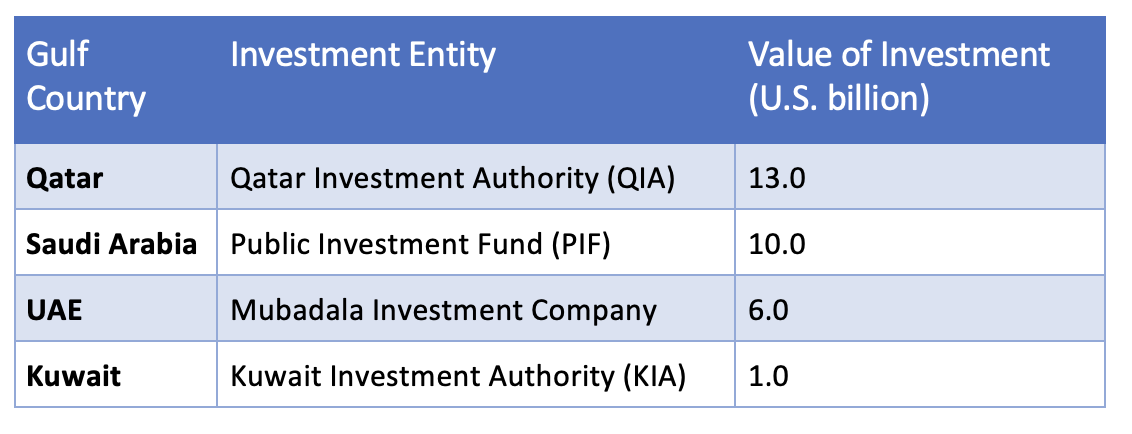
The primary drivers that have spurred Gulf-Russia cooperation are the new global oil market trends that emerged in the 2010s: 1) the U.S. shale oil revolution, which claimed a considerable share of the oil market, and 2) the global energy transition, which has led to calls for policies that phase out hydrocarbon-based energy technologies. These two factors have caused the oil supply to surpass demand and have played a major role in lowering oil prices to levels that might not fulfill the needs of net-oil exporting nations. In 2016, efforts by Saudi Arabia and Russia resulted in the Vienna Agreement between OPEC and non-OPEC countries (OPEC+) to coordinate production to stabilize oil prices. The Gulf states and Russia both seek to strike a balance between gaining more oil market share at the expense of low oil prices, on the one hand, and losing oil market share in favor of maintaining high oil prices, on the other.
One should note that Russia does not have sufficient financial resource capacities to widen its presence in the Gulf region. As a result of its comparatively weak economy, Russia’s political influence in the region is limited.
4. Gulf Oil Strategy Dynamics: A Proposed Model
Figure 6 depicts the development of the Gulf oil strategy as described in the previous sections and is used to model the overall oil strategy. The features of an era are the oil-related events and affairs that took place in a given time period. These features build drivers or motives toward adopting particular policies and implementing associated actions to handle present and potentially related future events. In theory, the overall oil strategy is a function of motives and drivers, which themselves are a function of existing and most probable events and affairs.
The theoretical structure allows inverse projection, i.e., given a particular oil strategy, the motives can be predicted, and consequently, events can be forecasted. The long-term Gulf oil strategy is anticipated by examining long-term scenarios of potential events using the proposed scenarios in the International Energy Agency’s World Energy Outlook 2022.
Figure 6 — Gulf Oil Strategy Development
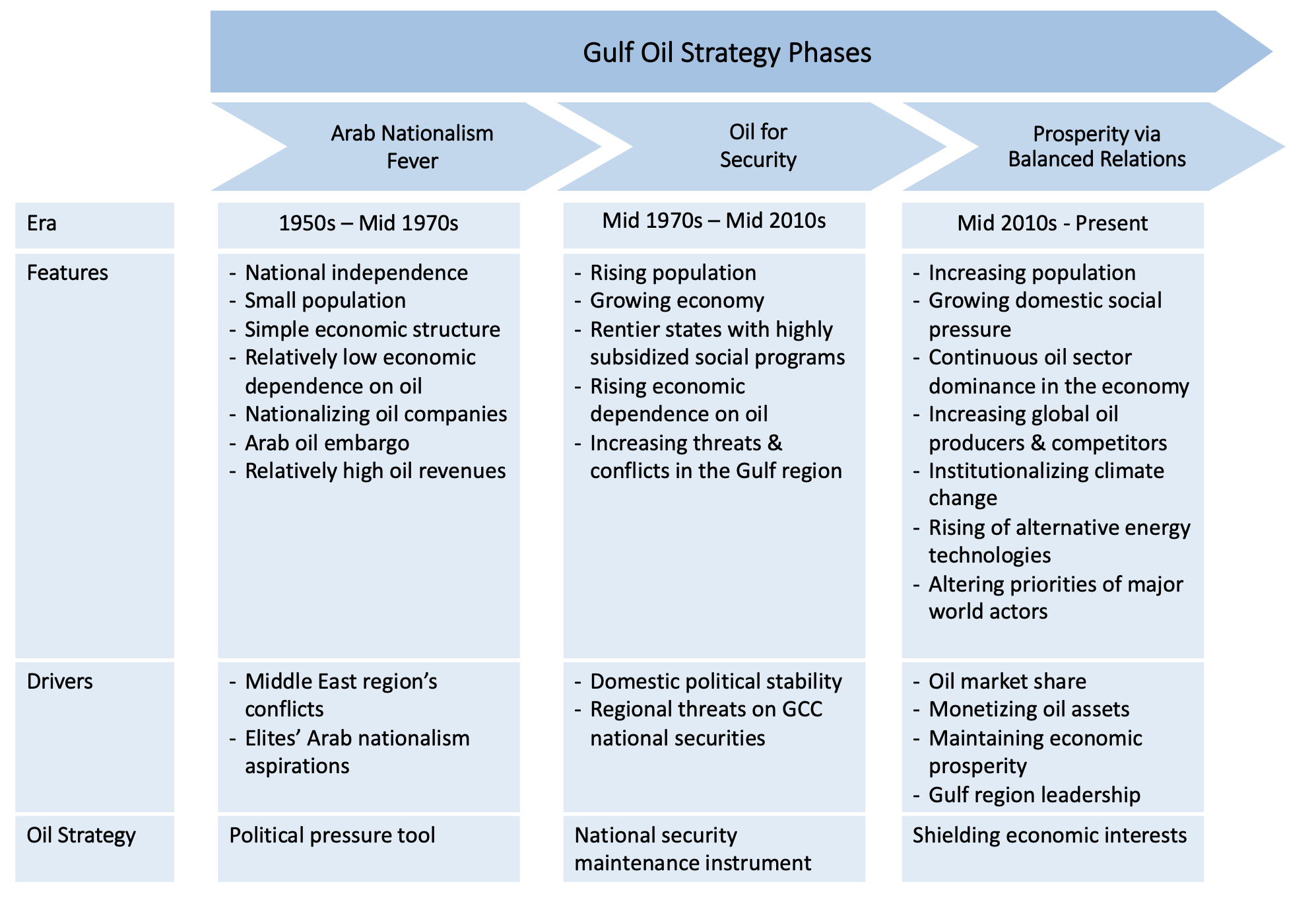
The IEA’s World Energy Outlook 2022 investigates three scenarios involving the future of the global energy system and the implications of various policy options.[41] The titles and definitions of the scenarios are as follows:
- Stated Policies Scenario (STEPS): The actual actions and accomplishments of governments in achieving energy and environmental targets and objectives, which have been set by various governments. This scenario does not take it for granted that governments will reach all announced goals.
- Announced Pledges Scenario (APS): The announced energy and climate commitments are fully achieved on time. However, global temperature rise is not necessarily limited to 1.5°C. In other words, a net-zero pledge for all greenhouse gas emissions does not necessarily mean that CO2 emissions from the energy sector need to reach net zero; instead energy-related emissions could be offset by the absorption of emissions from forestry or land use.
- Net Zero Emissions by 2050 (NZE) Scenario: The global energy sector achieves net-zero CO2 emissions by 2050. Global temperature rise is limited to 1.5°C, and key energy‐related UN Sustainable Development Goals are achieved by 2050.
This paper analyzes the IEA’s scenarios and their expected impact on Gulf oil producers. The anticipated effect of each IEA scenario on the world oil supply is depicted in Figure 7. Under the STEPS, the oil demand continues to grow with an average rate of 123 million barrels of oil equivalent (boe) per year to the mid-2030s. Then it would slightly decline with about an average rate of 16 million boe per year from the mid-2030s to 2050. The increase in renewable energy deployment up to 2030 would come at the expense of coal and natural gas. There would be near‐term increases in oil output in the U.S., Guyana and Brazil, in addition to the major producers in the Middle East. Accordingly, the share of OPEC countries in global oil production rises from 35% in 2021 to 36% in 2030, and 43% in 2050.[42] The main sectors requiring oil increase include petrochemicals, aviation, shipping and heavy trucks since the latter sector cannot be operated with electric vehicle technologies. There is no shortage of oil resources to cover this level of demand; however, the adequacy of investment in the oil sector is the main challenge facing the world oil supply.
In the APS, executing the announced clean technologies deployment and climate action plans on time would decrease the oil supply by an average rate of 409 million boe per year from 2021 to 2050. Under this scenario, more than half of the current refining capacity faces the risk of lower utilization or closure by 2050. The use of oil would be mainly for petrochemical feedstock.
In the NZE scenario, from 2021 to 2050, the oil supply decline rate would be 779 million boe per year. This decline would be driven by the vast decrease in oil-based combustion engine passenger vehicles between now and 2050. Moreover, the decrease in oil use in the petrochemical sector would be another contributor to the oil supply decline.
Due to the Russian invasion of Ukraine, Russian fossil fuel exports would never return to 2021 levels in all of the IEA’s scenarios. In the STEPS, Russia’s share of internationally traded oil and gas drops 50% by 2030.
Figure 7 — World Oil Supply Under the IEA Scenarios: (a) Supply of Crude and Oil Products, (b) Percentage Contribution of Oil with Respect to the Total Energy Mix
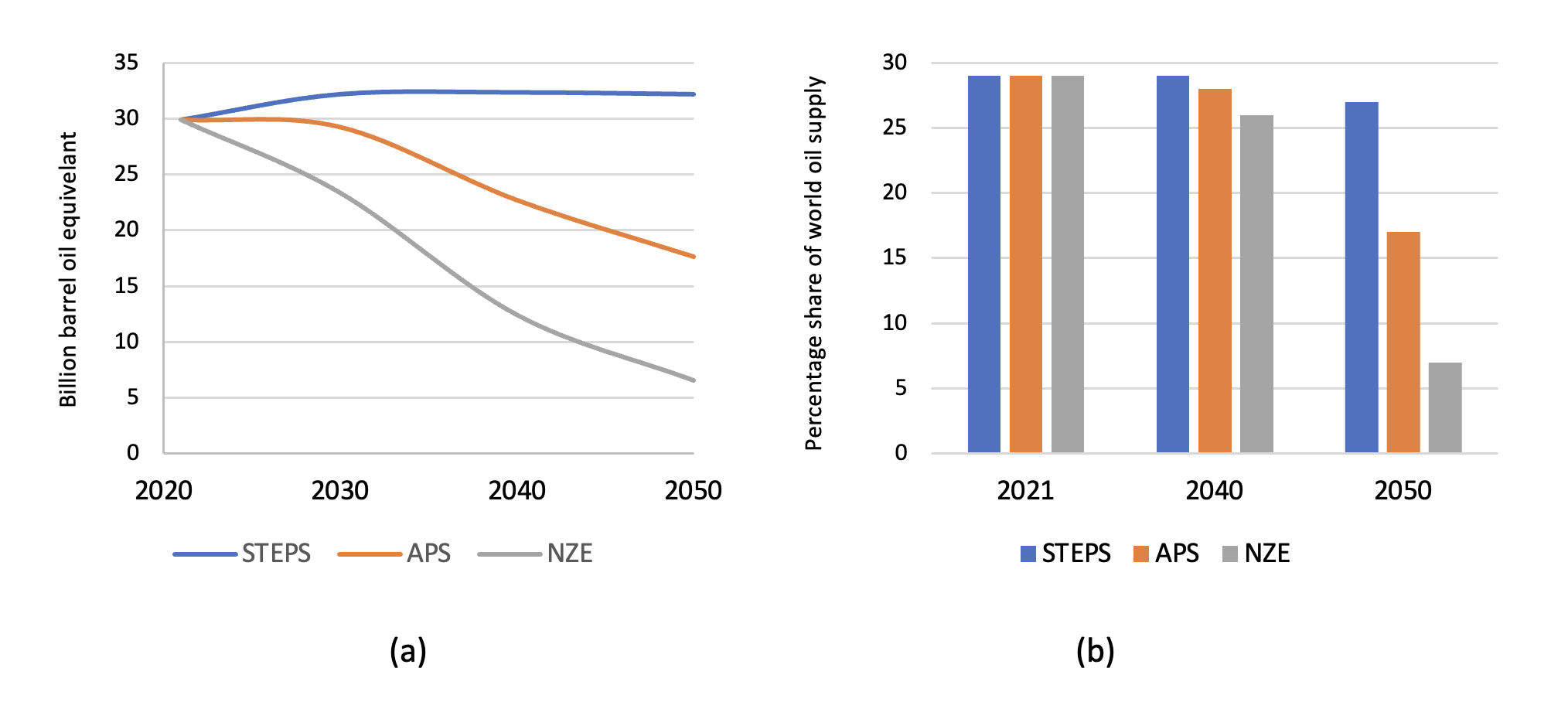
The main oil-relevant implications of the IEA’s scenarios are used as additional features in the current Gulf oil strategy model (Figure 6). The expected drivers (or motives) of the major Gulf oil producers are also derived from the IEA’s scenarios. Figure 8 summarizes the Gulf’s oil strategies under the three IEA scenarios.
Under the STEPS, the motives of the Gulf would be similar to the present aims as presented in Figure 6. However, there would be more active measures to increase their market shares to cover Russia’s missing share. Expediting the monetization of oil assets, the Gulf would continue to increase investments upstream and downstream in the oil sector. In addition to production and refining, the investments would target the integration of clean technologies (e.g., carbon capture, utilization and storage and hydrogen production) with the up and downstream oil facilities to reduce the sector’s carbon footprint and enhance product competitiveness in international markets. Since decoupling oil revenues from the economy will not be achieved in the foreseen long-term future under this scenario, the Gulf oil producers would continue collaborating with OPEC+ members to maintain desired price levels. Furthermore, the Gulf would persist in building relations with China to develop opportunities for economic diversification. The grand strategy under this scenario can be described as “shielding economic interests.”
The oil supply in the APS would reach 62 million and 48 million boe per day by 2040 and 2050, respectively. This considerable oil cut could push the Gulf oil producers to widen their coordination with other producers, including Iran. Despite the rampant hostility between Gulf nations (especially Saudi Arabia) and Iran, Iran would continue to pursue narrowing the gap with the Gulf Arab states. The growing socioeconomic pressure would push Iran to give up its current policies of interfering in the Gulf states’ internal affairs, leading to the partial lift of international sanctions and increased cooperation with the Gulf Cooperation Council (GCC) in handling oil market prices. Russia losing its oil share in the European market would open the door for the Gulf’s investments in Russia’s infrastructure and technologies to indirectly reach European markets. More oil producers would join OPEC+ as its members focus on their national economic interests. This environment would push the Gulf to pursue the non-energy use of oil through petrochemical industries. Furthermore, given China’s BRI investments in the region, Gulf-China relations would likely reach a higher strategic level with plans to transform the region into a hub not only for commercial trade, but also for exporting clean energy to Europe and Africa through the GCC interconnection electrical grid. The Gulf and China would collaborate on investments in neighboring regions (e.g., Jordan and Sudan) in construction, agriculture and telecommunications. Under the APS, the development of the GCC interconnection with the European continent via Iraq (in progress) and Turkey would accelerate, as would the interconnection with Egypt (in progress), North Africa and East Africa via the western and southern regions in Saudi Arabia. The rate of decline in oil supply would allow reasonable time for Gulf governments to manage domestic challenges involving the decay of social benefits due to low oil revenues. The Gulf’s sovereign wealth funds (SWFs) would play a key role in stabilizing the domestic political economy. However, they would be a partial solution for a sustainable economic system. The Gulf’s common grand strategy under the APS can be described as the “resilient oil economy.” The Gulf would have a mixed portfolio of assets to improve national income financial resilience.
The crucial challenge of the NZE scenario is the rapid decline of oil demand. The world oil supply would fall from more than 100 million barrels a day today to about 18 million barrels a day in 2050. Such a scenario would significantly affect the economic systems of the Gulf oil producers. Preparation for the NZE scenario requires immediate action to further develop and grow international investments, rapidly expand the non-oil sector, and expedite the execution of infrastructure and stimulus projects to strengthen non-oil sectors. Furthermore, the oil sector would go through fundamental changes in capital and operations seeking non-energy use. The main world actors would mostly lose interest in the Gulf region. However, China would still see the Gulf as a central link with Europe and Africa; therefore, Chinese investment in the form of construction, telecommunications and logistics would actively surge. Moreover, the NZE scenario would enforce a radical disruption of technology and societal behavior as Gulf nations pursue the “oil and national economy decoupling” grand strategy. Such disruption may destabilize the Gulf’s domestic politics. SWFs may mitigate the pressure, but they would not be able to provide the desired quality of living for a reliable, sustained long-term future.
Figure 8 — Expected Gulf Oil Strategies Under the IEA's Scenarios
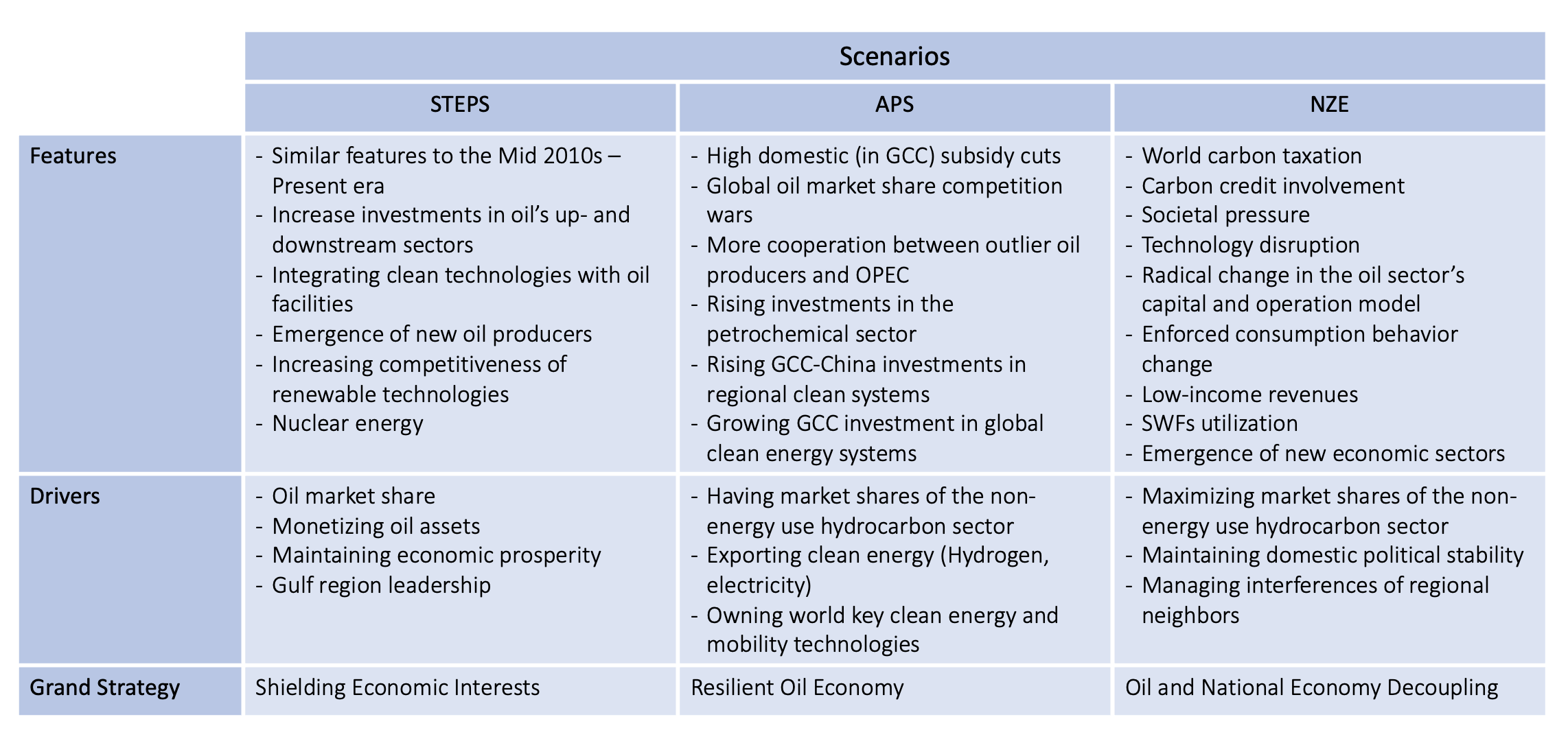
Discussion and Conclusion
The overall oil strategy of the Gulf region is comprised of both a desire to pursue economic interests and exercise political pressures. The strategy has shifted significantly in response to various political and economic developments in the past seven decades. From the mid-20th century to the early 1970s (before the establishment of the GCC), all of the Arab Gulf countries achieved independence. During this time, Arab nationalism was at its highest among the political elite and the public. The Gulf economies were simple and not highly dependent on oil revenues, and the region could afford to utilize oil as a tool to reflect its political preferences. This era was relatively short, and as populations and economies grew, dependence on oil revenues also increased.
From the mid-1970s to the mid-2010s, the Gulf region was plagued by tension, conflict and war. Oil-based economies and high-cost social programs pushed the Gulf states to depend on major world actors, specifically the U.S., to protect their regional stability and national security. Therefore, the general common strategy among the GCC countries was “oil for security.” The pivotal issues that made the GCC region lose its top priority level among the world’s main actors, i.e., the U.S. and Europe, included: (i) the energy transition (phasing out fossil fuels from the global energy system) and (ii) the U.S. shale revolution in the early 2010s, which led to increased oil production in the U.S. and the revocation of several millions of barrels of oil daily from the world’s oil demand markets.
Despite the disruptions in the GCC (e.g., Saudi Arabia, the UAE and Bahrain cutting relations with Qatar, and disagreements between Saudi Arabia and the UAE in handling the war in Yemen), the time period from the mid-2010s to the present has been distinguished by two primary pillars: (i) maximizing the monetization of oil assets, and (ii) adopting balanced relations with main world actors to secure their economic interests and protect their national securities. The present common strategy of Gulf oil producers can be described as “shielding economic interests and bolstering national security.”
In this paper, analyzing relevant historical events was necessary to develop a model of the Gulf oil producers’ strategy mechanism. The model can be considered a logic tree that consists of three modules: an era’s features, or the key oil-related events and affairs of the era; the drivers, or the resulting policies of an era; and the grand strategy, which represents the overall plan to fulfil the policies put in place by the drivers.
The model was used to foresee the potential oil strategy of Gulf states in the context of the global energy transition, using the IEA’s World Energy Outlook 2022 scenarios (abbreviated STEPS, APS and NZE) as case studies. Under the STEPS, the Gulf’s grand strategy would not significantly differ from the present strategy of “economic prosperity via unbiased relations.” However, it would entail increasing investments in the upstream and downstream of the oil sector, as well as integrating clean technologies with oil facilities to reduce the sector’s carbon footprint and enhance product competitiveness in international markets.
In the APS, the major potential transformation would be projected in wider coordination and collaboration between oil net exporters. This might compel even Iran to give up its current policies in the region and cooperate with Saudi Arabia. Moreover, Gulf-China relations would likely reach a higher strategic level with plans to transform the region into a hub for exporting clean energy to Europe and Africa through the GCC interconnection electrical grid. The Gulf strategy is described under APS as a “resilient oil economy” by seeking a mixed portfolio of revenues.
The NZE scenario is quite challenging for Gulf oil exporters. Under this scenario, the rate of the world’s oil supply would decline faster than any reform measures, even if applied fully today. For a country like Kuwait, where oil revenue accounts for more than 90% of its total income, its economy would significantly shrink, jeopardizing its political system. The Gulf would maximize the investments in non-energy industries and mitigate the impact of their oil-stranded assets. Accordingly, direct and indirect new economic sectors would be established. Despite the Gulf’s SWFs’ central role in stabilizing the economies, their cash influx would not be sustainable for providing long-term rentier services. The region's priority for the world’s major powers would also be significantly downgraded under this scenario. Yet, given China’s BRI, Chinese presence in the Gulf would grow, leading to heightened tensions between the West and China over the region. Under the NZE scenario, there would be a tangible decoupling of oil from the Gulf economies.
Given current global developments —including rising populations, emerging economies and political crises in Europe and elsewhere — the APS and NZE scenarios are unlikely to be implemented. The economic and political reasons for this are beyond the scope of this paper. However, by recognizing the historical, economic and geopolitical factors that have shaped the Gulf’s oil strategy, it may be possible to anticipate how the region will be impacted by whatever approach to the global energy transition is ultimately pursued. With global efforts to reach net-zero emissions already underway, it is important to continue examining the potential economic and political consequences for the Gulf region under a variety of future scenarios.
Endnotes
[1] BP (British Petroleum), “Statistical Review of World Energy,” 70th Edition, 2021, https://www.bp.com/content/dam/bp/business-sites/en/global/corporate/pdfs/energy-economics/statistical-review/bp-stats-review-2021-full-report.pdf.
[2] Milton L. Holloway, “Upheaval in the energy markets: the Arab Oil Embargo and the Iranian Crisis,” in Innovation Dynamics and Policy in the Energy Sector, ed. Milton L. Holloway (Academic Press, 2021), 153-203, https://doi.org/10.1016/B978-0-12-823813-4.00008-7.
[3] “The 1979 Oil Shock: Legacy, Lessons, and Lasting Reverberations,” The Middle East Institute, Washington, D.C., October 1, 2009, https://www.mei.edu/publications/1979-oil-shock-legacy-lessons-and-lasting-reverberations.
[4] Thai-Ha Le, Anh Tu Le, and Ha-Chi Le, “The historic oil price fluctuation during the Covid-19 pandemic: What are the causes?” Research in International Business and Finance 58, (2021), https://doi.org/10.1016/j.ribaf.2021.101489.
[5] “Energy & Sustainability — Vision 2030,” Saudi Arabia, accessed November 14, 2022, https://www.vision2030.gov.sa/thekingdom/explore/energy/; “UAE Energy Strategy 2050,” accessed November 14, 2022, https://u.ae/en/about-the-uae/strategies-initiatives-and-awards/strategies-plans-and-visions/environment-and-energy/uae-energy-strategy-2050; “Kuwait Energy Outlook,” Issues 2019 and 2020, Kuwait Institute for Scientific Research, Kuwait.
[6] “International Energy Security – Common Concept for Energy Producing, Consuming and Transit Countries,” Energy Charter Secretariate, 2015, Brussels, Belgium.
[7] Kuwait became an independent state in 1961, and Bahrain, Qatar and the seven Trucial States, which became the UAE, followed a decade later.
[8] The World Bank, https://data.worldbank.org/indicator/.
[9] Holloway, “Upheaval in the energy markets: the Arab Oil Embargo and the Iranian Crisis” ; U.S. Energy Information Administration, “Spot Prices for Crude Oil and Petroleum Products,” released on December 7, 2022, https://www.eia.gov/dnav/pet/pet_pri_spt_s1_d.htm.
[10] “The 1979 Oil Shock: Legacy, Lessons, and Lasting Reverberations,” The Middle East Institute; International Monetary Fund, “Statistical Appendix,”https://www.imf.org/-/media/Files/Publications/REO/MCD-CCA/2018/November/En/reo-statistical-appendix-cca.ashx.
[11] Thai-Ha Le, Anh Tu Le, and Ha-Chi Le, “The historic oil price fluctuation during the Covid-19 pandemic: What are the causes?”
[12] Nader Kabbani and Nejla Ben Mimoune. “Economic Diversification in the Gulf: Time to Redouble Efforts,” Brookings Doha Center, Doha, Qatar, January 31, 2021, https://www.brookings.edu/research/economic-diversification-in-the-gulf-time-to-redouble-efforts/.
[13] Manal Shehabi, “Diversification effects of energy subsidy reform in oil exporters: Illustrations from Kuwait,” Energy Policy 138, (2020), https://doi.org/10.1016/j.enpol.2019.110966.
[14] Olivier Durand-Lasserve, “Nationalization of the private sector labor force, quotas, matching and public jobs, an illustration with Saudi Arabia,” The Quarterly Review of Economics and Finance 86, (2022): 98-117, https://doi.org/10.1016/j.qref.2022.06.004.
[15] The Gulf states Bahrain and Oman, which are non-OPEC members, are members of OPEC+.
[16] Kristian Coates Ulrichsen, Mark Finley and Jim Krane, The OPEC+ Phenomenon of Saudi-Russian Cooperation and Implications for U.S.-Saudi Relations, Research paper no. 10.18.22. Rice University’s Baker Institute for Public Policy, October 18, 2022, https://doi.org/10.25613/0B0F-J592; Jim Krane, “U.S.-Gulf Relations After OPEC+ Production Cuts,” Arab Center Washington D.C., November 2, 2022, https://arabcenterdc.org/resource/us-gulf-relations-after-opec-production-cuts/.
[17] Bilal Saab, “From Dependents to Allies: America's Gulf Relations Need Reform,” The National Interest, July 5, 2020, https://nationalinterest.org/feature/dependents-allies-americas-gulf-relations-need-reform-163837.
[18] Eleonora Ardemagni. “The GCC in the global power cycle: The reform-security nexus,” Atlantic Council, October 7, 2022, https://www.atlanticcouncil.org/in-depth-research-reports/report/the-gcc-in-the-global-power-cycle-the-reform-security-nexus/; Eleonora Ardemagni, “Military Bases and the U.S.-China Rivalry: Gulf Monarchies Bet on Parallel Partnerships,” Italian Institute for International Political Studies, July 12, 2021, Milan, Italy, https://www.ispionline.it/en/pubblicazione/military-bases-and-us-china-rivalry-gulf-monarchies-bet-parallel-partnerships-31121.
[19] “China Won’t Stop Using Fossil Fuels Until Clean Sources Can Provide Enough Energy Security,” TIME, October 17, 2022, https://time.com/6222566/china-fossil-fuel-plan-xi-jinping/.
[20] “Jeddah Summit for Security and Development - Messages of the Saudi Crown Prince on oil, gas, and climate change (in Arabic),” Attaqa, July 16, 2022, www.attaqa.net.
[21] Shehabi, “Diversification effects of energy subsidy reform in oil exporters: Illustrations from Kuwait.”
[22] BP, “Statistical Review of World Energy,” 70th Edition, 2021.
[23] “Crude oil refinery capacity in China from 1970 to 2021,” Statista, accessed October 26, 2022, https://www.statista.com/statistics/273578/oil-refinery-capacity-of-china/.
[24] “China vs. U.S. Refining Industry,” Institute for Energy Research, June 17, 2022, https://www.instituteforenergyresearch.org/international-issues/china-vs-u-s-refining-industry/.
[25] “Countries of the Belt and Road Initiative,” Green Finance and Development Center, Shanghai, China, March 2022, https://greenfdc.org/countries-of-the-belt-and-road-initiative-bri/.
[26] “The Belt and Road Initiative – UAE,” Commercial Dispute Resolution, September 21, 2021, https://iclg.com/cdr-essential-intelligence/1100-cdr-the-belt-and-road-initiative-2021/uae.
[27] “UAE signs deals with China under Belt and Road Initiative,” Economist Intelligence, May 8, 2019, http://country.eiu.com/article.aspx?articleid=1857968369.
[28] Yang Han, “UAE project progresses under BRI,” China Daily, January 21, 2022, https://www.chinadailyhk.com/article/256991.
[29] “Saudi Arabia Receives Largest Share of China's BRI Investments,” Asharq Al-Awsat, July 26, 2022, https://english.aawsat.com/home/article/3780171/saudi-arabia-receives-largest-share-chinas-bri-investments.
[30] “China, Kuwait to intensify efforts for five-year cooperation plan,” China Global Television Network, January 12, 2022, https://news.cgtn.com/news/2022-01-12/China-Kuwait-to-intensify-efforts-for-five-year-cooperation-plan-16Loz4C0Uak/index.html.
[31] Dylan Gerstel, “It’s a (Debt) Trap! Managing China-IMF Cooperation Across the Belt and Road,” New Perspectives in Foreign Policy, no. 16, Center for Strategic and International Studies, October 17, 2018, https://www.csis.org/npfp/its-debt-trap-managing-china-imf-cooperation-across-belt-and-road.
[32] Nikolay Kozhanov, “Russia-GCC Economic Relations: When Quality Matters more than Quantity,” Insight Turkey 23, no. 1 (2021): 183-203, https://www.jstor.org/stable/26989823.
[33] Sarah Rundell, “Gulf SWFs have most exposure to Russia as crisis grows,” Top1000funds.com, March 3, 2022, https://www.top1000funds.com/2022/03/gulf-swfs-have-most-exposure-to-russia-as-crisis-grows/.
[34] “Jeddah Summit for Security and Development - Messages of the Saudi Crown Prince on oil, gas, and climate change (in Arabic),” Attaqa.
[35] Ibid.
[36] Dominic Dudley, “Middle East Investors Step Back From Russia Amid Ukraine Conflict,” Forbes, March 22, 2022, https://www.forbes.com/sites/dominicdudley/2022/03/28/middle-east-investors-step-back-from-russia-amid-ukraine-conflict/?sh=32b4e5864252.
[37] Holloway, “Upheaval in the energy markets: the Arab Oil Embargo and the Iranian Crisis.”
[38] “Jeddah Summit for Security and Development - Messages of the Saudi Crown Prince on oil, gas, and climate change (in Arabic),” Attaqa.
[39] “IMF sees quick Russian oil output recovery once OPEC+ deal is done, urges investments,” Reuters, February 9, 2021, https://www.reuters.com/article/imf-russia-oil-int/imf-sees-quick-russian-oil-output-recovery-once-opec-deal-is-done-urges-investments-idU.S.KBN2A920H.
[40] “Jeddah Summit for Security and Development - Messages of the Saudi Crown Prince on oil, gas, and climate change (in Arabic),” Attaqa.
[41] “World Energy Outlook 2022,” International Energy Agency, Paris, France, October 2022, https://www.iea.org/reports/world-energy-outlook-2022.
[42] Han, “UAE project progresses under BRI.”
This material may be quoted or reproduced without prior permission, provided appropriate credit is given to the author and Rice University’s Baker Institute for Public Policy. The views expressed herein are those of the individual author(s), and do not necessarily represent the views of Rice University’s Baker Institute for Public Policy.



